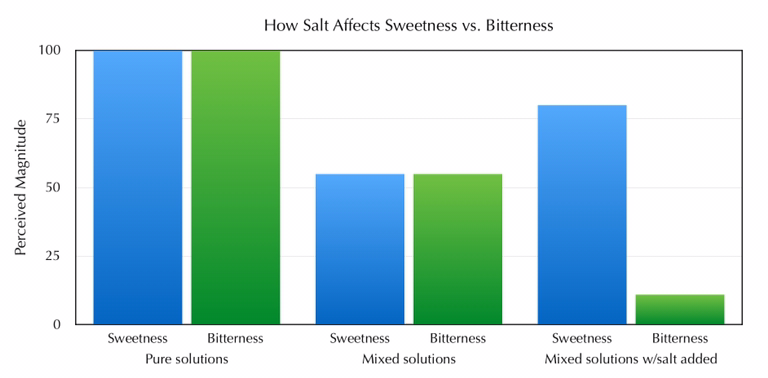Before refrigeration, salt’s #1 use was to preserve food. Nowadays, it’s most commonly used, instead, as a flavor enhancer. This is common knowledge. But it’s also pretty remarkable how universally it works. Whether you’re eating a chocolate bar, a serving of steamed broccoli, a steak, a grapefruit, a piece of toast, a handful of peanuts, or a plate of pasta, most people agree that the flavor is improved by adding salt, either during cooking (as with bread or chocolate) or to the finished dish (as with the steak or steamed veggies).

So the question arises: How is salt able to enhance such a wide range of flavors?
There are a couple of different mechanisms.
One is the denaturing of proteins in food. Denaturing is basically a change to the 3D shape of a protein molecule – they go from being tightly folded up to being more just like crooked strands.

When the shape changes, the molecules then bond together differently. It’s often visible as a physical change to a food, and it’s most commonly a result of heat from cooking. Think of an egg white. It’s clear and liquid until you cook it, and then it becomes white and solid. This is because the 3D shape of the protein molecules changed. Proteins can also be denatured by a strong acid or base, or other chemical elements found in food.

If you put lemon juice in milk, it curdles. And some proteins are denatured to an extent by the presence of salt in solution. So what does this have to do with enhancing flavor? When many proteins are denatured, aromatics are released. And of course, our sense of smell contributes to our sense of taste. So when our food has more aroma, the flavors become more vivid.
This mechanism is relatively minor, though, compared to what salt does really well: cancel out bitterness.
There are 5 primary flavors that we can detect: sweet, sour, salty, bitter, and umami. That last one is often described as “savory.”
Of these, bitterness is the black sheep. Although there are exceptions, most of the time, bitterness is a flavor we try to avoid. We often associate bitterness with a fruit or vegetable that was picked at the wrong time, or a dish that was improperly prepared.
Just how effective salt is at suppressing bitterness was demonstrated in a scientific study published by P.A.S. Breslin and G.K. Beauchamp. They prepared a a water/sucrose mixture to serve as a benchmark for sweetness and a water/urea mixture to serve as a benchmark for bitterness. So on a sweetness scale, the sucrose solution was 100, and on a bitterness scale the urea mixture was 100.
Then these two solutions were mixed together. Text subjects gave the mixture a sweetness rating of around 55 as well as a bitterness rating of around 55. So far, this seems pretty natural and predictable.
Now here comes the interesting part: they then added some salt to this mixture. Without adding or removing any sucrose or urea, the sweetness rating shot up to around 80, while the bitterness rating plummeted to roughly 11.

The affect is pretty remarkable. And it works similarly with sour and umami. By reducing the level of bitterness, the rest of these flavors are “freed up” and stand out much more. A good analogy might be a good pair of polarized sunglasses on a bright snowfield. With the naked eye, the glare tends to drown out colors. But with the dark polarized lens, colors appear more clear and vivid.
Salt enhances flavors through one other mechanism, which is much more obvious. Salt, being one of the primary flavors, simply complements the others very well. Think butterscotch (salt/sweet), soy sauce (salt/umami), or a margarita (salt/sour).
No wonder top chef Jacob Kenedy states that “correct seasoning” is “getting as much salt into a dish as you can without it tasting too salty.”
